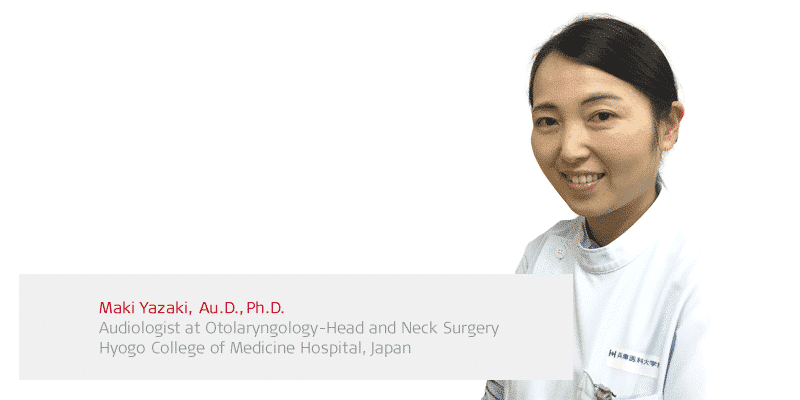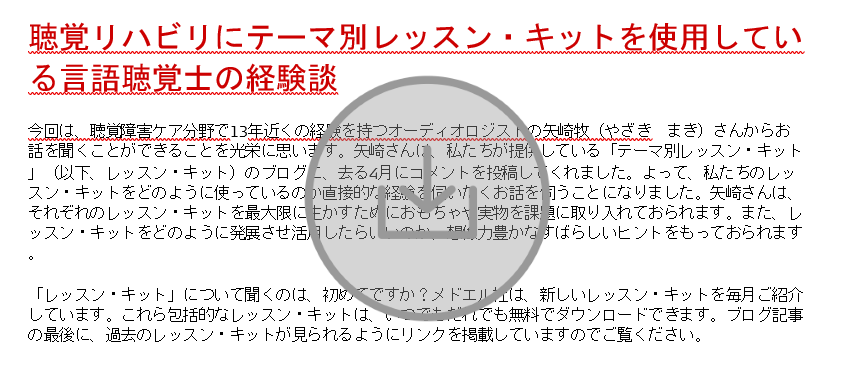MED-EL
Published Dec 14, 2018
An Audiologist’s Experience With Themed Lesson Kits for Aural Rehabilitation: Maki Yazaki

Today, we’re excited to hear from Maki Yazaki, an audiologist with nearly 13 years of experience in the field of hearing loss solutions. Ms. Yazaki commented on our Lesson Kits article in April, so we wanted to hear her first-hand experiences in using our Themed Lesson Kits. She has been using our Themed Lesson Kits and has great tips for integrating toys & objects and lots of creative ideas for expanding the activities to make the most of each kit.
Ms. Yazaki’s article is available in Japanese—download the pdf!
 New to our lesson Kits? Every month, we share a brand new Themed Lesson Kit for free download. All of these comprehensive lesson kits are always free to download—you’ll find links to all the kits at the end of the article.
New to our lesson Kits? Every month, we share a brand new Themed Lesson Kit for free download. All of these comprehensive lesson kits are always free to download—you’ll find links to all the kits at the end of the article.
We created these lesson kits to provide ready-made resources for listening & spoken language specialists, audiologists, speech & language pathologists, rehabilitation specialists, and any other professional that works with children with hearing loss.
Each kit has activities to target specific listening, language and cognitive goals. Each lesson kit is 40–80 pages, and includes instructions, therapy goals, lesson plans, and printable illustrations. Each lesson kit begins with a step-by-step explanation of how to use the lesson kit. This includes an explanation of the key that is used on each lesson plan. There are listening goals, speaking goals, and cognitive or theory of mind goals.
The lesson kits also include language-neutral illustrations for the activities, which can be useful for adapting the kits for any language. Ms. Yazaki has been adapting the resources to use in Japanese, so she has helpful tips for using the language-neutral resources.
Ms. Yazaki has a Master’s degree in Audiology from University of British Columbia, School of Audiology and Speech Science. She has worked as an Audiologist in Canada and is currently an Audiologist in the ENT department at Hyogo College of Medicine Hospital in Japan.
Let’s go over to Ms. Yazaki to learn about her experiences with using our Themed Lesson Kits in her cochlear implant rehabilitation practice.
Lesson Kits: An Audiologist’s Perspective
I work with patients of all ages. I use ASSR, ABR, & OAE to help evaluate hearing status, and I do both cochlear implant mapping and cochlear implant rehabilitation.
I found about the MED-EL Professionals Blog and Lesson Kits from Rebecca Claridge, who was a guest speaker at the AVT workshop held in the summer in Nagoya, Japan in 2017. She introduced to us that there are “free” downloadable materials available for anybody interested.
I started using the Lesson Kits since then. I am very happy that it is free for everybody, because the parents can also download the materials so that they can work with the same materials, too.
Interactive Rehabilitation Activities
These Lesson Kits are useful because you can come up with new activities by reading them and you can get a lot of ideas what to do for children. I do not necessarily go through a full kit with each child every month, but I pick up the activities that seem to be fun and manageable for the children I see.
Most of the children I work with are at level 1 and level 2, so I often use them for these children. I do see few children at level 3, but they seem to enjoy it too. I found the “Go Fish” activities hard to keep attention for children at younger age. When they are very young, it may be better to use 3D toys rather than picture cards. So, I sometimes replace the picture cards with 3D toys whenever possible for the little ones.
For example, from the theme of “fruits and vegetables”, I laminated the fruit and vegetable cards and attached magnets to them. For level 1 children, I let them fish for the cards using a fishing rod with a magnet. They can name them and sort them out one by one as they “catch” the card. For example, after picking up a banana card, they will hear “Oh, you caught a banana! Let’s put it in the banana basket.”
For level 2 children, I can ask them to pick two cards and put the cards on the wall according to the category (fruits vs. vegetables). After putting the cards on the wall, I can ask them to count, “How many apples do you have”? and count the number of apples, etc.
There are a few challenges. Some of the Lesson Kits cannot be used directly in Japanese culture. For example, the 17th Lesson Kit “Sharks and Whales” may be hard to use in Japanese because categorization seems to be a bit different from English.
For example, it is possible to categorize “shoes, pants, hats” under a category of “clothing” in English, but is it hard to put them under one category in Japanese. We also have to find songs and rhymes that are equivalent to the songs written in the lesson kits, but it is sometimes hard to look for.
Engaging Multiple Senses
The children seem to enjoy the interactive ones, such as building a house from the 1st Lesson Kit or making a chef’s hat from the 2nd Lesson Kit. They seem to enjoy when they can use their senses and hands.
For example, in the 2nd Lesson Kit for children at level 2, I use the verb dice and food dice and let the children cast the two dice. After rolling the dice, I let the children “wash” toy food in a container filled with water, cut it with a toy knife on the cutting board, or cook it on the toy pan according to the dice.
Another example is from the second activity of the 8th lesson kit “Faces and Hands”. For children to feel how soft the teddy bear is, I put the teddy bear in a bag so they can concentrate on “feeling”. I let them guess what’s in the bag out loud, or I let them select their guess from the picture cards.
I sometimes put a real banana or an apple in the bag and let the children feel it and smell it without letting them see it. I ask the parents to touch the object inside the bag and let them describe what they feel and smell too: “It’s cold and smooth.”, “It smells sweet”, “I wonder what’s inside?”, etc.
The 2nd Lesson Kit is one of my favorites. Children love playing cooking, playing house, and pretend play. It is hard to control when they are really into it, but making it a game can be a good learning experience for them.
Learning New Techniques
The therapist notes and goals are very helpful because you know what the activity is aiming for and how it is done. By reading them, you learn a lot about AVT strategies and techniques applied in the activities.
It is nice that I can learn the techniques by practice, and to have a community of professionals who are open to share the ideas and resources and materials like MEDEL’s lesson kits.
Thank you Maki Yazaki!
Subscribe & Share
Did you know we already have 20 free lesson kits published? And the first kit is already translated into Portuguese, French, German, and Russian?
We’ll be taking a holiday break for this month, but look for Lesson Kit #21 in January!
In the meantime, make sure you have all the lesson kits and check out this great article with Rebecca Claridge, creator of the Themed Lesson Kits.
Don’t miss the next lesson kits—subscribe to the MED-EL Professionals Blog now to get each new article sent right to your inbox!
Have a question? Leave a comment below! And don’t forget to share the lesson kits, we’re sure your coworkers will find them useful!
*We’d like these kits to help as many people as possible, so the Themed Lesson Kits may be shared openly for fair usage. However, MED-EL retains full rights to the material, so the content may not be altered, rebranded, or repurposed for commercial use.
**Not all products, features, or indications for age shown are available in all areas. Please contact your local MED-EL representative for more information.
MED-EL
Was this article helpful?
Thanks for your feedback.
Sign up for newsletter below for more.
Thanks for your feedback.
Please leave your message below.
CTA Form Success Message
Send us a message
Field is required
John Doe
Field is required
name@mail.com
Field is required
What do you think?
The content on this website is for general informational purposes only and should not be taken as medical advice. Please contact your doctor or hearing specialist to learn what type of hearing solution is suitable for your specific needs. Not all products, features, or indications shown are approved in all countries.
MED-EL



